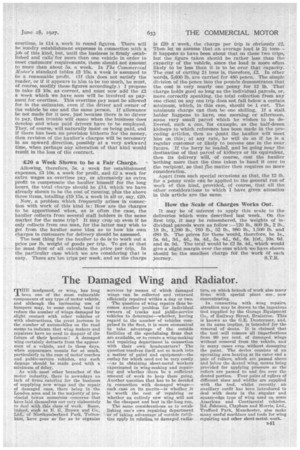The Damaged Wing and Radiator.
Page 59

If you've noticed an error in this article please click here to report it so we can fix it.
THE mudguard, or wing, has long been one of the most vulnerable Components of any type of motor vehicle, and although the increasing use of bumpers may, to some extent, tend to reduce the number of wings damaged by slight contact with other vehicles or with obstructions, the great increase in the number of automobiles on the road seems to indicate that wing Makers and repairers have no need to despair of the future of their 1;tusiness ! A damaged wing certainly detracts from the appearance of a vehicle, and in these days, when appearance counts for so much, particularly in the case of motor coaches and public-service vehicles, any such damage 'should be made good with a minimum of delay.
As with most other branches of the motor industry, there is nowadays no lack of firms catering for the business of supplying new wings and the repair of damaged ones, there being in the London area and in the majority of provincialtowns numerous concernsthat have laid themselves out very elaborately to deal with this class of work. Some, indeed, sneb as E. G. Brown and Co., Ltd.. of Northumberland Park, Tottenham, have gone so far as to organize services by means of which damaged wings can be collected and returned efficiently repaired within a day or two.
The question of wing repairs thus becomes another problem for individual owners of trucks and public-service vehicles to determine—whether, having regard to the -number of vehicles comprised in the fleet, it iS more economical to take advantage of the outside facilities of the specializing firms that are available, or, to create a wing-making and repairing department in connection with their own headquarters? The ride.stion resolves itself not so muCh into a" matter of paint and equipment—the outlay for which need not he very costly --as in obtaining sheet-metal workers experienced in wing-making and repairing and whether there be a sufficient amount of work to keep them. going. . Another question that has to be decided in connection with damaged wings— each case on its meritsis whether_ it is worth the cost of repairing or whether an entirely new wing will not be the cheapest and best in the long run. The same considerations as to establishing one's own repairing department or of taking advantage of °IASI& faeilities apply in relation to damaged radia tors, on which branch of work also many firms with special plant are now concentrating. In c:onnection with wing repairs, attention may be drawn to the ingenious tool supplied by the Garage Equipment Co., of Railway Street, Braintree. This is known as the G.E. Deriterazer, and, • ds its name implies, is intended for the removal of dents. It is claimed that the tool will remove all imperfections from 90 per cent, of damaged. wings without removal from the vehicle, and in many cases even without damaging the paint. The device consists of an operating arm bearing at its outer end a pair of rollers, which are passed above aid below the dented wing, means being provided for applying pressure as the rollers are passed to and fro over the dented portion. Four pairs of 'Viers of different sizes and widths are supplied With the tool, whilst recently an auxiliary outfit has been introduced to deal with dents in the angular and square-edge. type of wing used on some American and Continental vehicles. Rd. Sehnson, Clapham and Morris, Ltd., Trafford Park, Manchester, also make many useful machines and tools for wing repairing and other sheet-metal work.




































































































